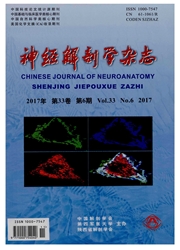

 中文摘要:
中文摘要:
CB(calbindin-D28k),CR(calrctinin)和PV(parvalbumin)是最常见的3种钙结合蛋白(calcium-binding proteins,CaBPs)。本研究首先观察了面口部给予伤害性刺激诱发大鼠延髓背角(又称三又神经脊束核尾侧亚核)神经元表达FOS蛋白的状况;然后通过免疫荧光组织化学技术检测这些神经元内是否含有CaBPs(CB,CR和PV);最后通过免疫荧光和免疫电镜染色技术观察5-HT、GABA、甘氨酸转运体2(glycine transporter 2,GlyT2),脑啡肽(cnkephalin,ENK)或SP与CaBPs/FOS双标神经元间的联系。在光镜下可观察到:(1)FOS阳性神经元在延髓背角各层均有分布,以Ⅱ层最为密集;(2)大多数CB、CR或PV阳性神经元位于Ⅱ层,余者分布在Ⅰ层和Ⅲ层;(3)5-HT、GABA、GlyT2,ENK及SP阳性纤维和终末主要位于延髓背角浅层(4)部分FOS阳性神经元同时呈CB、CR或PV阳性;(5)5-HT、GABA、GlyT2或ENK阳性终末分别与FOS/CB、FOS/CR或FOS/PV双标神经元形成密切接触;(6)SP阳性终末与5-HT、GABA、GlyT2或ENK阳性终末同时与CB、CR或PV阳性神经元形成密切接触。在电镜下观察到5-HT、GABA、GlyT2或ENK阳性终未与CB、CR或PV阳性神经元主要形成对称型(抑制性)突触联系。这些结果提示在大鼠延髓背角,5-HT,GABA、甘氨酸或ENK可能通过抑制含钙结合蛋白的伤害性感受神经元来调节面口部伤害性信息的传递。
 英文摘要:
英文摘要:
Calbindin-D28k ( CB), calretinia (CR) and parvalbumin (PV) are the most common calcium-binding proteins (CaBPs). In the present study, FOS immunoreactivity was first induced in neurons of the medullary dorsal horn (MDH) of the rat by noxious orofacial stimulation; CaBPs (CB, CR and PV) in these neurons were then identified by immunofluorescence histochemistry, and then, in addition, afferents to CaBPs/FOS double-labeled neurons were showed by immunofluorescence histochemical staining for the γ-aminobutyric acid ( GABA), glycine transporter 2 ( GlyT2 ), enkephalin ( ENK), serotonin (5-HT) or substance P (SP). Under the light microscope, we observed that: (1) neuronal cell bodies exhibiting FOS-immunoreactivity were present throughout all laminae of the MOH, with the highest concentration in lamina Ⅱ ; (2) most CB-, CR- and PV-immunoreactive (IR) neurons were located in lamina Ⅱ , but some were also encountered in laminae Ⅰ and Ⅲ ; (3) 5-HT-, GABA-, GlyT2-, ENK- and SP-IR fibers and terminals were also chiefly located in laminae Ⅰ and Ⅱ of the MDH ; (4) some FOS-IR neurons showed CB-, CR-, or PV-immunoreactivity ; (5) 5-HT-, GABA-, GlyT2- and ENK-IR terminals made close contacts with FOS/CB, FOS/CR or FOS/PV double-labeled neurons: (6) SP-IR terminals, as well as 5- HT-, GABA-, GlyT2- or ENK-IR terminals, closely contacted CB-, CR- or PV-containing neurons. Under the electron microscope, 5- HT-, GABA-, GIyT2- anti ENK-IR terminals principally made symmetric (inhibitory) synaptic connections with CB-, CR- and PV-containing neurons were observed. These results suggest that 5-HT, GABA, glycine (Gly) and ENK may modulate transmission of orofacial noxious information by inhibiting noeiceptive neurons that contain CaBPs in the rat MDH.
 同期刊论文项目
同期刊论文项目
 同项目期刊论文
同项目期刊论文
 期刊信息
期刊信息
